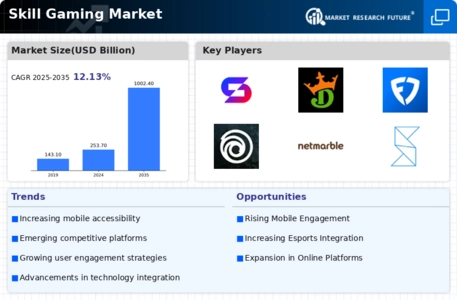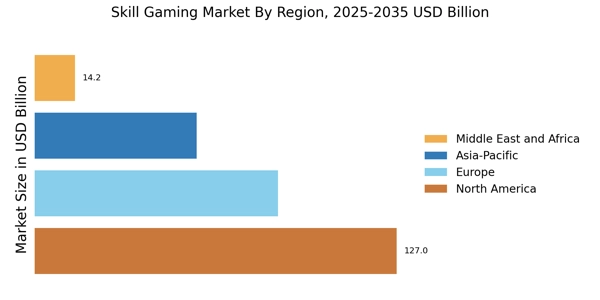Rise of Social Gaming
Social gaming is emerging as a pivotal driver within the Skill Gaming Market, as players increasingly seek communal experiences. The rise of multiplayer platforms and social features in games fosters interaction among players, enhancing the overall gaming experience. This trend is evidenced by the growing number of social gaming platforms, which have reported user engagement rates exceeding 70%. As players connect and compete with friends and family, the Skill Gaming Market is likely to see increased participation and retention rates. This communal aspect not only enriches gameplay but also encourages the development of new skill-based games that cater to social interactions.
Increased Accessibility
The Skill Gaming Market experiences a notable surge in accessibility due to the proliferation of mobile devices and high-speed internet. As smartphones become ubiquitous, individuals from diverse demographics can engage in skill-based games anytime and anywhere. This accessibility is further enhanced by the availability of various platforms, including social media and dedicated gaming applications. According to recent data, the number of mobile gamers has reached over 2.5 billion, indicating a substantial audience for skill gaming. This trend suggests that as more players enter the market, the potential for revenue growth and innovation within the Skill Gaming Market expands significantly.
Evolving Consumer Preferences
Consumer preferences are shifting towards interactive and engaging gaming experiences, which is driving growth in the Skill Gaming Market. Players increasingly seek games that not only entertain but also challenge their cognitive abilities and skills. This trend is reflected in the rising popularity of competitive gaming formats, such as esports, where skill is paramount. Market data indicates that the esports industry alone is projected to surpass 1.5 billion in revenue by 2025, highlighting the demand for skill-based competition. As consumers gravitate towards these experiences, the Skill Gaming Market is likely to adapt and innovate to meet these evolving expectations.
Regulatory Support and Frameworks
The establishment of regulatory frameworks is becoming a crucial driver for the Skill Gaming Market. Governments are increasingly recognizing the potential economic benefits of skill gaming, leading to the development of supportive regulations. These frameworks aim to ensure fair play, protect consumers, and promote responsible gaming practices. Recent data indicates that regions with clear regulations have seen a 20% increase in market participation. As regulatory environments become more favorable, the Skill Gaming Market is poised for growth, attracting both investors and players who seek a secure and legitimate gaming experience.
Integration of Artificial Intelligence
The integration of artificial intelligence (AI) into the Skill Gaming Market is transforming the gaming landscape. AI technologies enhance user experiences by personalizing gameplay, providing adaptive challenges, and improving matchmaking systems. This technological advancement not only increases player engagement but also fosters a more competitive environment. Market analysis suggests that AI-driven gaming solutions could account for a significant portion of the industry, with projections indicating a growth rate of over 30% in AI applications within gaming by 2026. This evolution may lead to more sophisticated skill-based games, thereby attracting a broader audience to the Skill Gaming Market.


















Leave a Comment